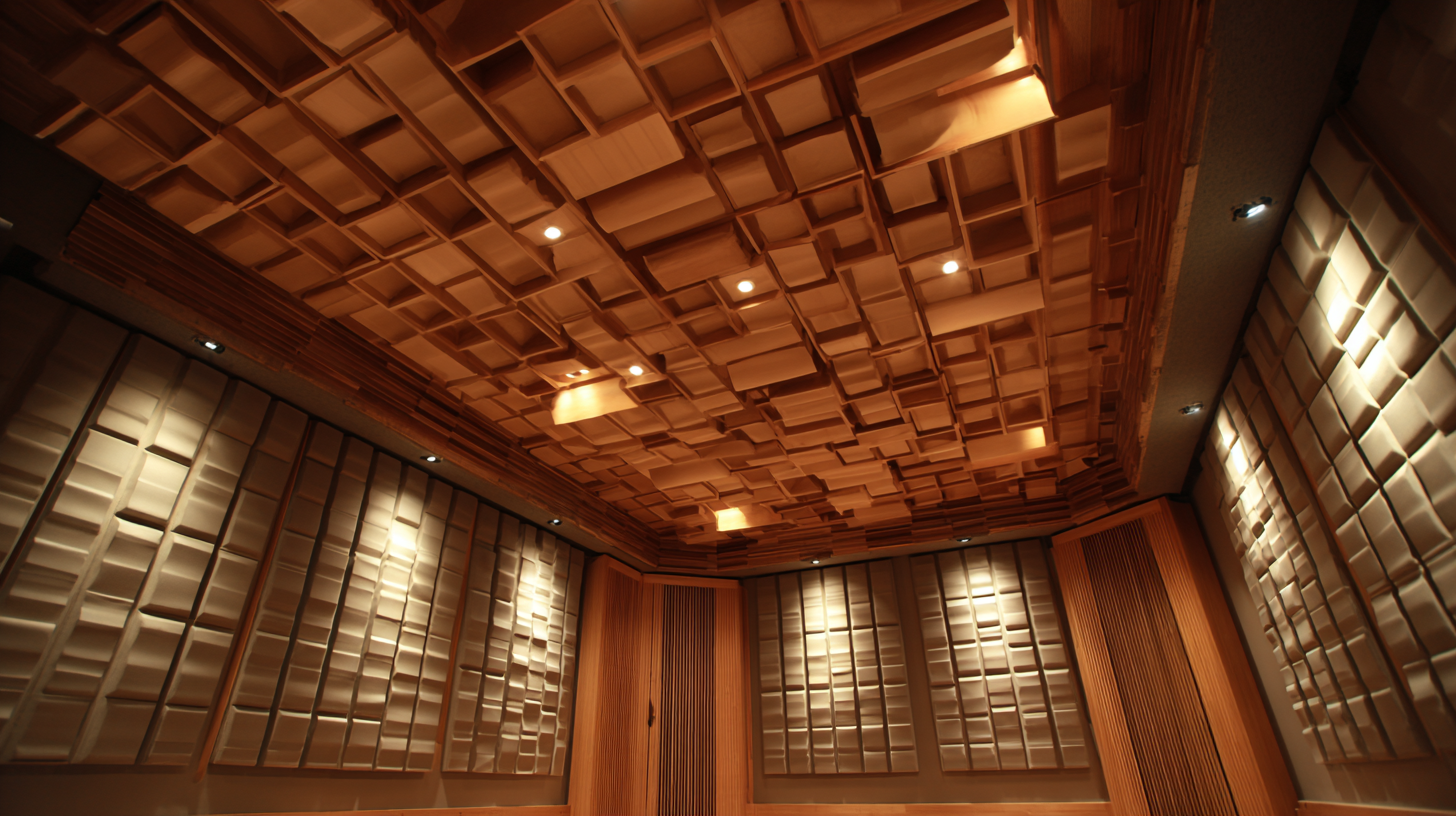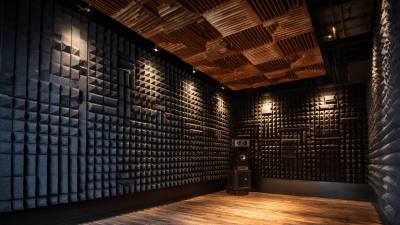 In recent years, the quest for optimal acoustic treatment in various environments has led to a surge in the use of innovative solutions, with "sound panels for ceiling" emerging as a pivotal game changer. These specially designed panels not only enhance sound quality but also provide aesthetic appeal, making them a top choice for both residential and commercial spaces. With the rising awareness of the importance of acoustics in productivity and comfort, understanding the science behind these sound panels is essential for anyone looking to improve their auditory environment.
In recent years, the quest for optimal acoustic treatment in various environments has led to a surge in the use of innovative solutions, with "sound panels for ceiling" emerging as a pivotal game changer. These specially designed panels not only enhance sound quality but also provide aesthetic appeal, making them a top choice for both residential and commercial spaces. With the rising awareness of the importance of acoustics in productivity and comfort, understanding the science behind these sound panels is essential for anyone looking to improve their auditory environment.
This exploration delves into the mechanisms by which sound panels for ceiling function, highlighting their role in sound absorption, reflection, and diffusion. From the materials used to the design principles involved, we will uncover how these panels can significantly reduce noise levels and improve overall sound clarity. Additionally, tips on effective installation and placement will be discussed, ensuring that you can maximize the potential of your acoustic treatment setup. Whether you are setting up a home theater, a recording studio, or simply looking to enhance the ambiance of your living space, mastering the art of sound panel placement can lead to remarkable improvements in sound performance.
The significance of acoustic treatment in modern spaces cannot be overstated, particularly as the demand for enhanced sound control continues to rise in various environments such as offices, schools, and public venues. According to industry projections, the Architectural Acoustic Panels Market is set to grow significantly, with expectations to reach a value of $13.76 billion by 2032, reflecting a compound annual growth rate (CAGR) of 5.5% starting from 2024. This growth highlights an increasing recognition of the role that sound management plays in creating productive and harmonious spaces.
Recent developments in acoustic design, such as the introduction of innovative acoustic pods and new materials, demonstrate the industry's commitment to enhancing sound quality in contemporary architecture. For instance, educational institutions are implementing tailored acoustic solutions to optimize learning environments, utilizing specialized panels designed to meet both acoustic and sustainability standards. As architects and designers explore fresh approaches to spatial arrangements, the integration of effective acoustic treatments will be crucial in shaping workspaces that are not only functional but also conducive to focus and collaboration.

Sound panels play a pivotal role in modern acoustic treatment, particularly in reducing noise levels and enhancing sound quality within interior spaces. These panels are designed to absorb sound waves, thus minimizing echo and reverberation. Research by the Acoustical Society of America indicates that the use of sound panels can reduce noise levels by up to 50%, significantly improving the auditory experience in environments like offices, theaters, and recording studios. The effectiveness of sound panels hinges on their material composition, size, and placement, which are crucial for optimal performance.
In understanding how sound panels function for noise reduction, one must acknowledge the science of sound absorption. Different materials, such as foam and fabric, have varying levels of acoustic properties. According to a study published in the Journal of Building Acoustics, high-density foam panels can achieve an NRC (Noise Reduction Coefficient) rating of 0.90 or higher, indicating exceptional sound-absorbing capabilities. This means that they can absorb 90% of the sound that strikes their surface, making them a valuable asset in soundproofing strategies. By effectively managing sound within a space, these panels not only contribute to a more pleasant auditory environment but also foster enhanced communication and productivity in professional settings.
| Dimension | Description | Effectiveness |
|---|---|---|
| Material Type | Acoustic foam, fabric, wood | High absorption rates, reduces echo |
| Thickness | 1-inch to 4-inch options | Thicker panels = better noise reduction |
| Placement | Ceiling, walls, corners | Strategic placement increases effectiveness |
| Fire Rating | Class A to Class C | Safety standard compliance is crucial |
| Color Options | Various colors and patterns | Aesthetic appeal enhances environments |
The installation of ceiling sound panels offers significant benefits across various environments, particularly in enhancing acoustic treatment. In healthcare settings, for instance, proper acoustics can contribute to patient recovery by reducing unnecessary noise, allowing for a more restful and healing atmosphere. Studies have shown that quiet environments can alleviate stress, improve sleep quality, and promote faster healing, making acoustic design a crucial component in modern healthcare facilities.
In office spaces, ceiling sound panels can create a more productive work environment by mitigating distractions caused by noise. Implementing sound masking techniques and establishing quiet zones significantly contribute to employee focus and overall job satisfaction. Moreover, in educational settings, the impact of acoustics on learning is profound. Noisy classrooms can hinder students' ability to concentrate and absorb information, while well-designed acoustic solutions can foster a better learning experience, supporting both teachers and students alike. As the demand for effective acoustic solutions continues to grow, the global market for acoustic ceiling tiles is projected to reach USD 11.53 billion by 2033, highlighting the increasing recognition of their value across diverse applications.

When it comes to enhancing the acoustics of a space, understanding the sound absorption coefficients of different materials is crucial. Sound panels designed for ceilings can play a significant role in controlling reverberation and echo, ultimately improving the sound quality. Each material utilized in these panels offers various levels of sound absorption, which is often quantified using a coefficient scale ranging from 0 to 1. For instance, soft materials like fabric-wrapped fiberglass and foam tend to have higher coefficients, making them effective at dampening sound waves. In contrast, harder materials like wood and metal exhibit lower coefficients, playing a more reflective role in an environment.
Tips for choosing the right sound panels include assessing the primary purpose of the space. For recording studios or home theaters, opt for materials with high absorption coefficients to minimize sound reflections. Conversely, in spaces like offices where conversations need to be audible yet contained, a balance of reflective and absorptive materials may be beneficial. Remember to consider aesthetics as well; many sound panels are available in various designs that can enhance your interior decor while providing acoustic benefits.
Ultimately, the right choice of sound panels can transform a room's acoustics. Conducting a comparative analysis of material properties can lead to informed decisions that meet both functional and aesthetic goals. Always consider the specific acoustical challenges of your space to select the best options available.
The implementation of sound panels in ceilings has proven to be a transformative element in various acoustic treatments, as demonstrated by real-world case studies. For instance, in a corporate office environment, the integration of ceiling-mounted acoustic panels led to a reported 30% reduction in ambient noise levels, enhancing employee focus and productivity (Acoustic Science Journal, 2022). Similar results were observed in educational institutions where classrooms equipped with innovative acoustic designs experienced a 25% improvement in speech intelligibility, an essential factor for effective learning (Learning Environment Research, 2021).
**Tips:** When considering sound panels for your space, assess the room's size and purpose. Larger spaces might require thicker panels to effectively dampen noise, while smaller rooms can benefit from strategically placed, lighter panels. Additionally, combining sound panels with other acoustic treatments, like carpets or drapes, will yield even better results. Always prioritize aesthetics alongside functionality to ensure that the acoustic solutions complement your overall design vision.






